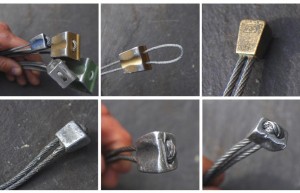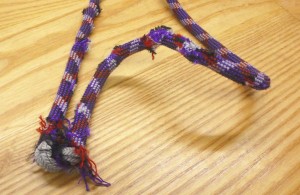There are various standards that each and every piece of protective equipment must pass for it to be fit for purpose and saleable, often involving randomized destruction testing during manufacture. As we use and abuse the kit we need to be able to make informed decisions as to when to retire and replace our equipment. This section contain information that will help you with basic climbing equipment maintenance.
General rule of thumb on equipment maintenance and life
- Metal Equipment – 10 year life span.
- Webbing – 5 years Storage (On shop shelf) and then ve years use.
- Ropes – 5 years from the date of manufacture.
It is important to realise that heavy use might reduce these lifespans.
There is anecdotal evidence that metal work in particular can withstand the test of time. DMM tested a featherlite carabiner from the 1960’s which still broke at 20kN, similarly they have run ‘Break what you Brung’ workshops as various events and have found twenty year old carabiners regularly breaking at there cited strength. This is possible because Aluminium hardens with age, which also means that a new wire is slightly plastic and may mould itself into a crack slightly when you fall on it, but and older wire may not. Whilst this shouldn’t compromise the placement it is an interesting consequence of metal ageing.
Wires

Check your wires regularly, by examining the swaged wire rope for damage, if any of the strands are broken then it is time to replace it (the strength will be effected and the sharp wire may abrade your webbing or rope). Slide the metal wedge down the wire to see what is going on underneath it too.
Karabiners
It is a myth that if you drop a carabiner on the floor from the slightest height it may magically hit a sweet spot, causing micro-fractures and compromising the integrity of the carabiner. Aluminium carabiners are forged at over 400 degrees Centigrade so the metal forms strong molecular bonds that are elastic. However if you drop a piece of gear down and entire pitch and it lands on solid rock then you would be advised to retire it.
All metal work is liable to corrosion especially if you climb at or near the coast. Salt in the air will stick to the metal and stay there slowly corroding the metal whilst it languishes in your rucsac until the salt is washed away. Rinse all hardware in fresh water after climbing at sea cliffs, to limit corrosion. Gear is often anodised, which creates a barrier to corrosion, however, any scratch to the anodised surface exposed the metal underneath to the corrosive environment, so even anodised equipment needs a rinse.
Cams
Cams (with all their moving parts) need to be regularly oiled with specific oils like the Metolius cam oil, they can also be cleaned using Metolius Cam Cleaner. Maintaining the cams will prevent them from seizing up and consequently needing to be replaced. Oil the axle which the cams rotate around and make sure all the cams move independently of the axle and each other. Sometimes a long fall onto a cam or dirt will stop the cams moving independently, making the cam less stable when placed. Also the trigger wires can break but can often be replaced by returning the unit to the manufacturer for a small charge. If the unit is over ten years old they will not replace the trigger.
Both cams and hexes have a webbing sling, which will have a lifespan less than the metal parts. These can be replace by the manufacturer at a price. Webbing is more susceptible to damage from UV ligh and also abrades quickly. Abrasion causes more damage than you might imagine.
Destruction tests show a new dynema sling cut completely through 1/3 of the width of the sling, and then abraded across its whole width, will snap first where it is abraded before it tears at the cut. This is why the five year rule of thumb is best understood as a maximum lifespan, as heavy use will result in abrasion all over the sling.
Harnesses
Harnesses may also suffer abrasion, general wear and tear as well as specfic wear points (where the buckles are tightened and loosened every time we put a harness on and take it off and also where the rope is threaded through the strong point of the harness).
A worn harness was the cause of the death of Todd Skinner, a famous and experienced climber, who had order a new harness that hadn’t arrived prior to his climbing trip.
Ropes
Your rope too needs to be inspected and maintained, the rope’s lifespan of ve years would also be best seen as a maximum life. Heavy use or dam- aged from being weighted over an edge may damage the sheath of the rope or the core, if the damage is severe then retire the rope. You should check your rope every time you use it (you probably do this without realising), as you ake the rope out, feel it run through you hands, feeling for uffy sec- tions or irregularities in the rope, then check these section more thoroughly, if it feels like the core is damaged then it is better to replace the rope than risk your life.

Don’t treat your rope badly – don’t step on it, dry it after use if it gets wet, wash it from time to time in fresh water and don’t add your own half way marks with marker pens (which may damage the sheath).
Whilst UV will damage rope just like webbing and slings, it is less of an issue with rope as the sheath with represents about 10% of the overall strength of the carabiner, the remain 90% strength provided by the core is protected, recent tests of insitu abseil tat exposed to an alpine environment, has shown whilst reduced in strength compared to slings the reduction is not as dangerous as slings exposed to UV. Store your rope away from direct sunlight.

